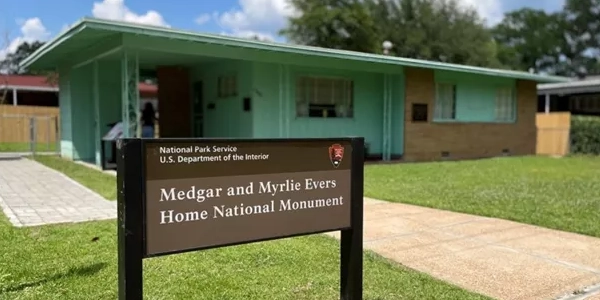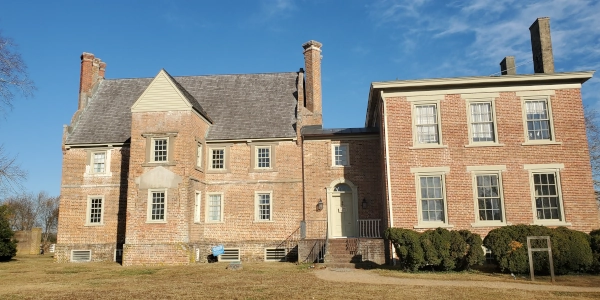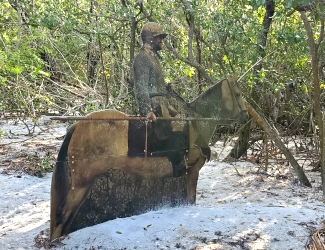
Image above: Metal sculpture along the De Soto Trail within the Memorial denoting conquistador De Soto riding through the mangrove forest just in from the beach. Courtesy America's Best History.
Spotlight on Lesser Known History
De Soto National Memorial
Florida
De Soto Expedition
America's Best History Spotlight
On this page we're going to Spotlight the lesser known historic sites and attractions that dot the history landscape across the USA and are worth a visit if you're in their area. And while they may be lesser known, some are very unique, and will be that rare find. You'll be, at times, on the ground floor, or maybe even know something others don't. It'll be fun. Visit them.
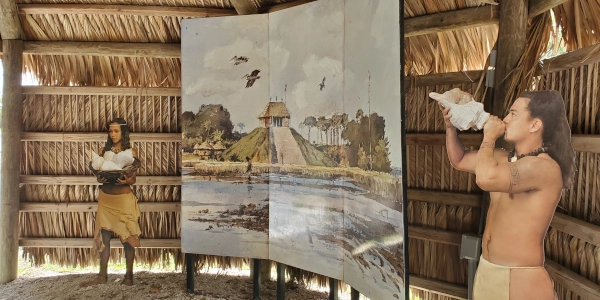
De Soto National Memorial, Florida
This park is a treasure, and we're not saying that because Hernando de Soto assumed that the gold and silver treasures of South America and Mexico would be onshore, we're saying that because De Soto National Memorial is a must see when you visit Florida, expecially if you're anywhere near the West Coast, but even if not. For us, an eleven site tour over five days took us all over the state, and this park was our second favorite (sorry, Matanzas was just a bit ahead), but it's way beyond that hot monster park, the Everglades, This National Memorial tells the story of Hernando de Soto's expedition of 1539 that brought six hundred men to establish the colony of La Florida from Florida to Virginia, from Florida west, who really knows, but he made it to the Mississippi. However, as with all colonial efforts, he was not alone when he arrived on May 30, 1539. There was a priest/explorer, Juan Ortiz, who had lived with the Indians who could translate. There were Native Americans, who he would become quickly dependent on for food, but he also enslaved some of the tribe to be servants, many in chains, and allowed his men to ravage the women. We didn't say the story was good.
Photo above: Metal statues and drawing within an exhibit hut at De Soto National Memorial of the Native Uzita society that was there at the landing site on the west coast of La Florida, America's Best History.
Sponsor this page for $100 per year. Your banner or text ad can fill the space above.
Click here to Sponsor the page and how to reserve your ad.
Info, What's There Now, History Nearby
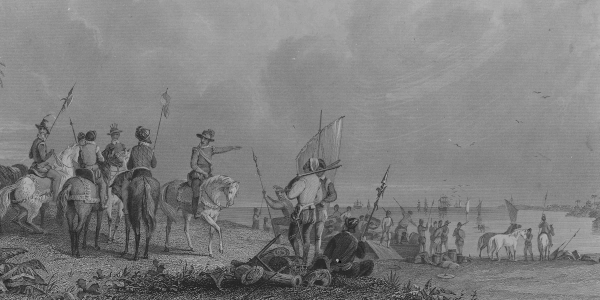
De Soto National Memorial, Florida
The voyage had been arduous, but De Soto, with his 622 men, plus women, priests, and others had landed in a hospitable place, particularly if you like wind, a dense mangrove forest, and the currents of the Manatee River. He was greeted mostly by desertion after he had taken over the Uzita camp or village to use as his base. The tribes had already been ravaged by the diseases brought by earlier missions. They, by July 8, 1859, had mostly deserted the country around the foot of the bay for thirty leagues. He had brought along two hundred horses and fierce dogs to keep he natives in line along the journey. De Soto would leave one hundred men and women at this location to start a colony while he ventured north and west over the next three years. He had orders from King Charles V not to harm the Natives as the Catholic Church wanted to convert them; in their lust for gold, they harmed them anyway. The more important of De Soto's agreement with the King to him was the arrangement that he could keep 80% of the loot he gained by battle or trade and 50% of that by plundering. He would also become governor of Cuba and the new colony after the expedition. Spoiler alert, he would not make it.
Image above: Drawing of De Soto with Expedition Landing Party at DeSoto National Memorial Site, 1653, James Smylie. Courtesy Library of Congress. Below: Statue of native American on shores of inlet off Tampa Bay. Courtesy America's Best History.
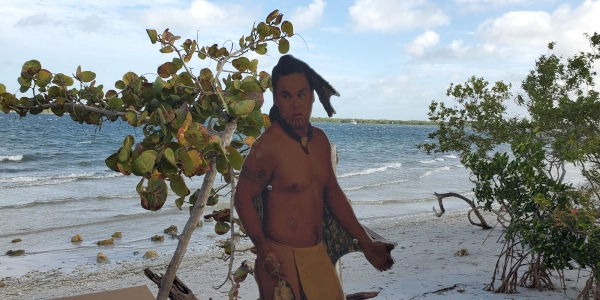
Where Is It
De Soto National Memorial is located at 8300 De Soto Memorial Highway, Bradenton, Florida 34209, which is approximately fourteen miles off Interstate 75 and through the town itself. There is gas and food along the way, but not at the park itself.
Minute Walk in History
Take a walk around the spectacular, but lesser known historic site, denoting the landing spot of Hernando De Soto in 1539, with walking trails, indoor and outdoor exhibits, amid a hard landscape of weather, lots of wind, the native tribes, and more as De Soto started his journey for the Mississippi River from this spot near now Bradenton, Florida. No silver or gold. Darn it. Music courtesy of Steve Owens.
What is There Now
De Soto National Monument
Although the park is small, a little over twenty-six acres, a state park beside adds extra acres and attractions to see. Not that you'll need to go over there, just that you might. The park itself is wonderful. You walk through a gate, as if its a fort. A replica of the original village/base camp actually sits outside that gate. The wind whips off the Manatee River as you climb a small hill toward the waterside. Waysides exist everywhere; so do sculptures of the Conquistadors and the Natives, with new and restored waysides on the way soon. The Visitor Center is bright, includes exhibits and a twenty-one minute film. There is a book store as well as restrooms. Outside you have picnic tables, although the wind the day we visited would have blown your food to Orlando. The De Soto Trail, however, meanders through the Mangrove Forest right along the water, and is a wonderful walk through history. At its farthest end are the Holy Eucharist Monument and the Memorial Cross. There is no camping allowed in the park.
Living history demonstrations and talks are held Thursday, Friday, Saturday, and Sunday in the winter season. In April, there is a reenactment of the landing.
When Open and How Much
No fee. The site is open daily 9 a.m. to 5 p.m. There is parking for cars and RV's.
Fees and hours are subject to change.
Websites
De Soto National Memorial
History Nearby
There's so much to see within the state of Florida, it's hard to pick a few to note. Of course, for most coming to the state will have to do with visiting a mouse at Disney World or the world at Epcot center, and they are nearly directly across the isthmus from this area in Orlando. There are many state historic sites, beaches, and Florida spring training sites near Brandenton. For the National Park fan, except for Gulf Shores National Seashore, the other parks are on the Atlantic Ocean side of the state, but they are all worth the drive, if you have the time, and if you've planned ahead, especially if you are camping.
Photos, History, and More Spotlights
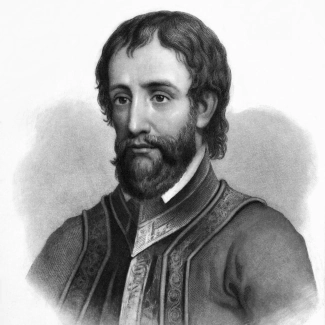
Hernando de Soto
You'd have to say Hernando was almost born to be a conquistador, although he had actually been born into modest nobility in Extremadura in 1497. His first voyage to the Americas, at the age of fourteen, took him to Panama with Pedro Arias Da´vila, and Nicaragua, where he became rich through gold and slave trading. He would participate, with one hundred and sixty eight soldiers, in the first conquest of the Incan Empire in Peru with Francisco Pizarro in 1532. His early exploits brought him fame for bravery and tactics; his heros were those of Ponce de León and Balboa, so there was an attraction to the Americas above the Caribbean and Mexico. Therefore, the establishment of this second voyage, when he was thirty-six, should come as no surprise. The first excusion had brazened him to make the second voyage count. His bravodo three years later would cost him his life near the banks of the Mississippi River after he had led his men from the landing spot across the southeast to the midwest Mississippi River.
Photo above: Engraving of Hernando de Soto, pre 1858, John Sartain and Robert Telfer. Courtesy Wikipedia Commons.
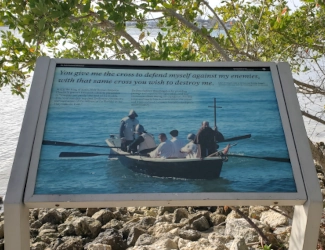
Native Americans Encountered
The main tribe of the area were the Uzita. It was the name of a 16th-century native chiefdom associated with the Safety Harbor culture. Their territory was known as south of present day Tampa Bay along the Manatee River and Little Manatee River, in today's Hillsborough County. The main town of Uzita, on the Little Manatee, included a house for the chief located atop a mound, betweem five and ten houses of wood and palm thatch, each housing a large number of people, and a temple. The tribe were the first to encounter both the Narváez expedition in 1528 and that of De Soto. The were known to use bows and very long arrows. Juan Ortiz, who was sent to look for the missing Narváez expedition was captured by the Uzita and held for twelve years, he had escaped to a nearby town, until De Soto arrived.
Image above: Depiction of boat coming ashore from De Soto's fleet to meet the Native Americans, hopefully in peace. Courtesy America's Best History.
Buy Second Edition
America's Best History Timeline

Great book to keep middle school to college students up to date on their American history.
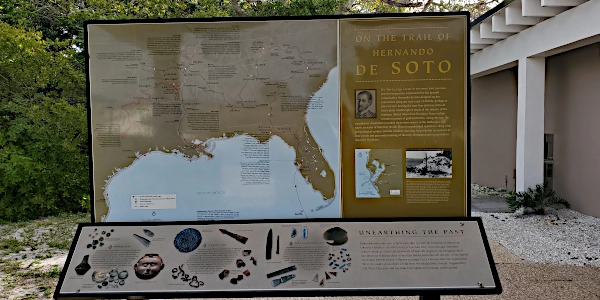
Remainder of the Expedition
The remainder of the expedition brought no gold, but did discover, by European standards, many locations within Florida, Georgia, South Carolina, Alabama, Mississippi, Arkansas, and Texas over the next three and one half years. Some locations noted; Winter 1540, Anhaica, Appalachi village now preserved as DeSoto Site Historic State Park. Fall 1540, Aute. April 1540, Ocmulgee. July 1540, Coosa. August 1540, Etowah. December 1540, Apafalaya. June 1541, Pacaha. De Soto would die on the western bank of the Mississippi River, in Arkansas or Louisiana, on May 21, 1542. Along the path, there were many battles, most brought on by the expedition. They would return to Mexico City; the expedition party was now down to three hundred and eleven men from its initial total strength of nearly seven hundred.
Photo above: Wayside along the De Soto Trail denoting the landing party as they approach shore, father holding a cross, and hoping to meet friendly Native Americans. Courtesy America's Best History. Below: Interior of the De Soto National Memorial Visitor Center.
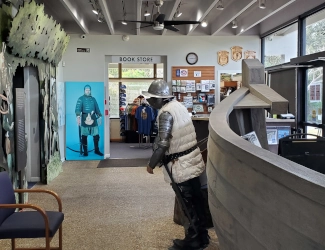

T-Shirts and Gifts from the official souvenirs of Americasbesthistory.com.
About
America's Best History where we take a look at the timeline of American History and the historic sites and national parks that hold that history within their lands.
Photos courtesy of the Library of Congress, National Archives, National Park Service, americasbesthistory.com and its licensors.
- Contact Us
- About
- © 2024 Americasbesthistory.com.
Template by w3layouts.
